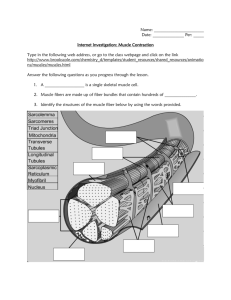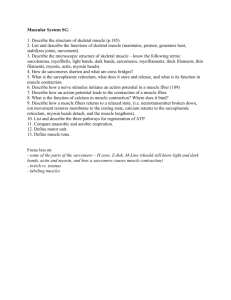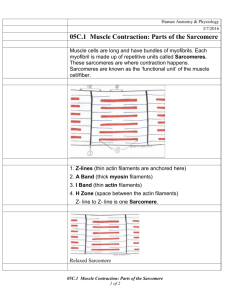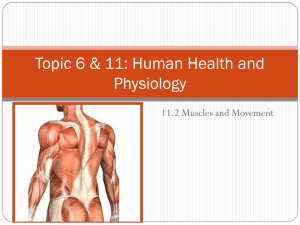Muscle Contraction & Neuromuscular Junction Worksheet
advertisement
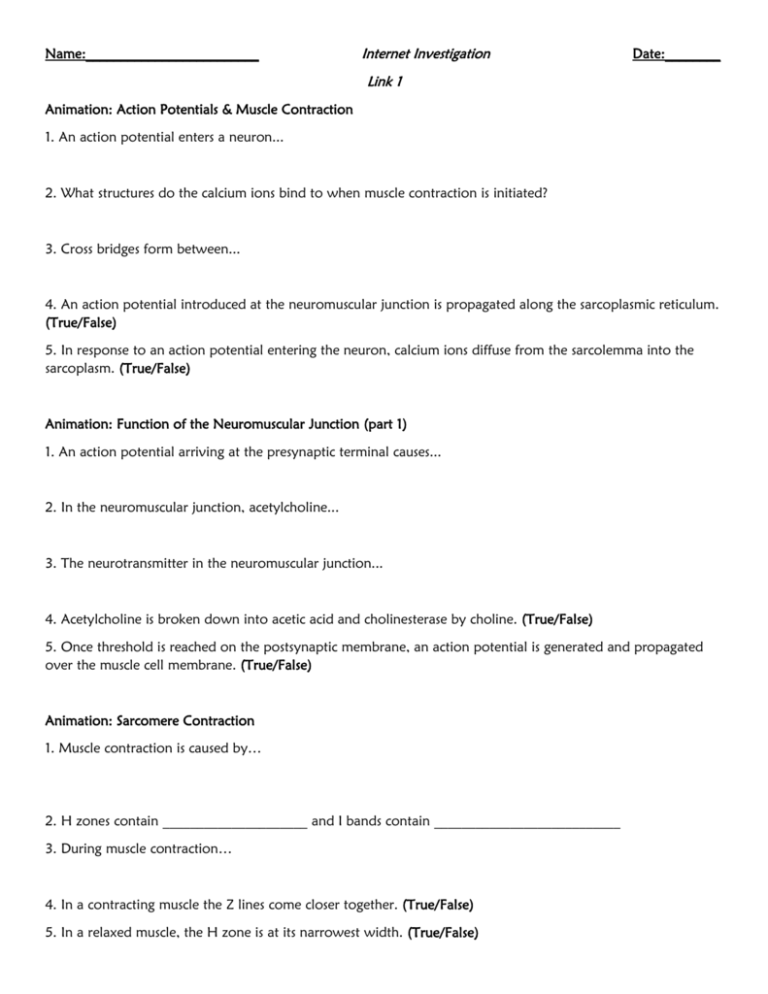
Name:_________________________ Internet Investigation Date:________ Link 1 Animation: Action Potentials & Muscle Contraction 1. An action potential enters a neuron... 2. What structures do the calcium ions bind to when muscle contraction is initiated? 3. Cross bridges form between... 4. An action potential introduced at the neuromuscular junction is propagated along the sarcoplasmic reticulum. (True/False) 5. In response to an action potential entering the neuron, calcium ions diffuse from the sarcolemma into the sarcoplasm. (True/False) Animation: Function of the Neuromuscular Junction (part 1) 1. An action potential arriving at the presynaptic terminal causes... 2. In the neuromuscular junction, acetylcholine... 3. The neurotransmitter in the neuromuscular junction... 4. Acetylcholine is broken down into acetic acid and cholinesterase by choline. (True/False) 5. Once threshold is reached on the postsynaptic membrane, an action potential is generated and propagated over the muscle cell membrane. (True/False) Animation: Sarcomere Contraction 1. Muscle contraction is caused by… 2. H zones contain _____________________ and I bands contain ___________________________ 3. During muscle contraction… 4. In a contracting muscle the Z lines come closer together. (True/False) 5. In a relaxed muscle, the H zone is at its narrowest width. (True/False) Link 2 Answer the following questions as you progress through the lesson. 1. A _____________________________ is a single skeletal muscle cell. 2. Muscle fibers are made up of fiber bundles that contain hundreds of ______________________________. 3. Identify the structures of the muscle fiber below by using the words provided. You may write the whole word or just the letter. A B C D E F G H I 4. Match the descriptions with the correct muscle fiber structure. Use the words above, and put the letter on the line next to the matching description. (Not all words will be used) ______ i. Composed of a T-tubule, the terminal cisternae, and gaps. ______ ii. Cylindrical structures that carry out contraction ______ iii. Extensions of the sarcolemma that separate the sarcomeres ______ iv. Specialized plasma membrane of the skeletal muscle cell; forms membrane connections between each of the sarcomeres. ______ v. The specialized endoplasmic reticulum of the skeletal muscle cell ______ vi. Units of the myofibrils 5. Identify the parts of the sarcomere below by using the words provided. You may write the whole word or just the letter. A B C D 6. Match the descriptions with the correct sarcomere part. Use the words above, and put the letter on the line next to the matching description. (Not all words will be used) ______ i. The bands that mark the sarcomere’s borders ______ ii. The bands that mark the middle of the sarcomere ______ iii. Under a micrograph, they are the lightest and least dense structures; composed of actin, troponin, tropomyosin ______ iv. Much more dense than thin filaments; composed of myosin 7. Who were the contributing scientists that discovered how muscle contraction worked? 8. The distance between the ends of the thin filaments was known as ____________ __. 9. The distance between the thick filaments of one sarcomere and the thick filaments of an adjacent sarcomere was known as the _________ ____. 10. The length of the thick filaments was known as the _________ ______. 11. Identify the areas in the following picture below 1 _________________ 2 2 _________________ 3 _________________ 1 3 12. The _________________ and ________________ shortens, but the _________________ does not shorten during muscle contraction. 13. Chemically, muscle contraction is driven by ___________________________ and triggered by the release of _____________________ from the sarcoplasmic reticulum. 14. Ca2+ binds to ______________________ in the thin filaments, exposing the myosin binding sites on actin. 15. The movement where the myosin head pulls the thin filaments inward is called the __________________. 16. Place the following events in order by placing a number (1-6): _______ Power stroke (ADP and P dissociate from myosin). _______ Thin filament returns to relaxed state _______ Ca2+ binds troponin causing a conformational change of the thin filament _______ Myosin heads bind to actin _______ Electrochemical signal causes release of Ca2+ from sarcoplasmic reticulum _______ ATP binds myosin head
